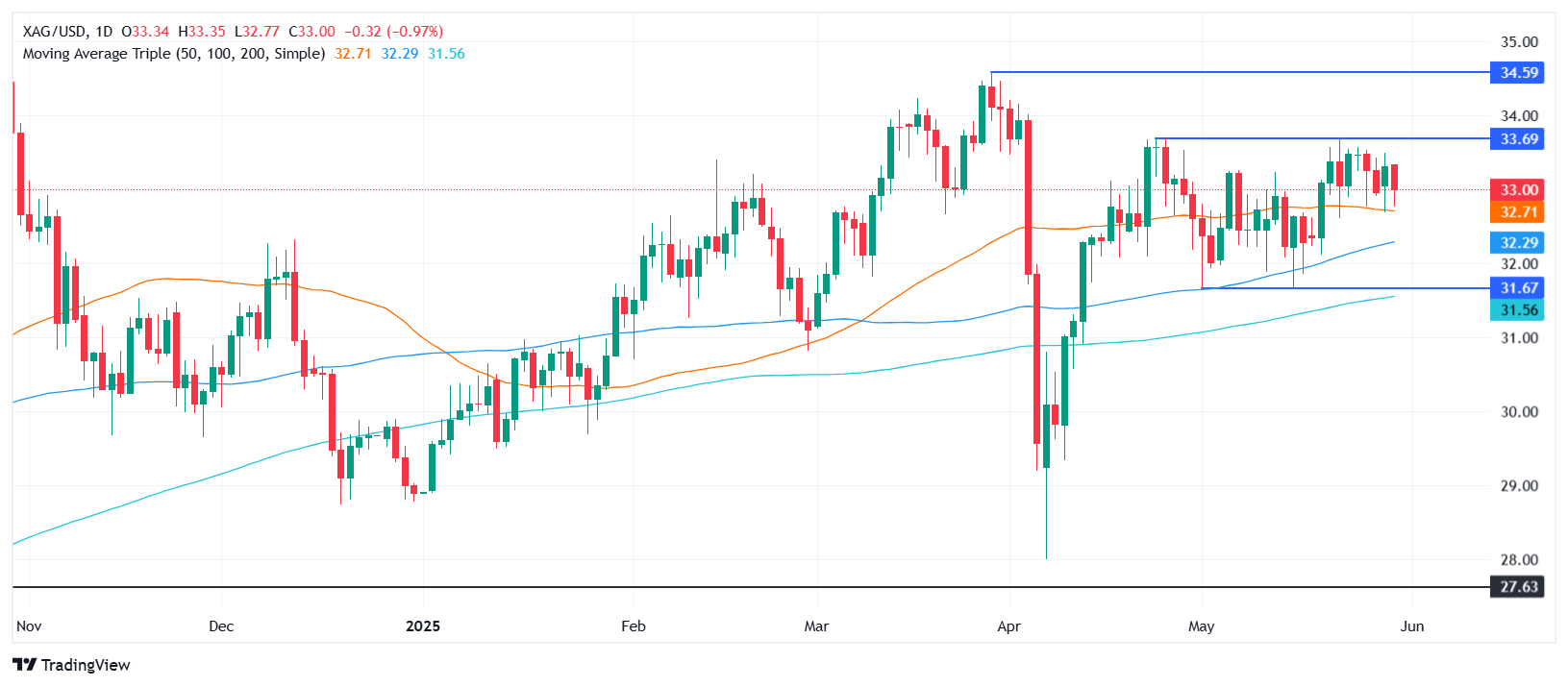Silver Price Forecast: XAG/USD plummets below $33.00 as Dollar rebounds, weekly losses near 2%
- Silver poised to end week down over 1.80% as strong Dollar pressures metals.
- Bearish harami pattern and soft RSI suggest downside bias could accelerate.
- Key support lies at $32.70 and 50-day SMA; upside capped by $33.69 and $34.00.
Silver price turned negative on Friday during the North American session, poised to end the week with losses of over 1.80% as the dollar staged a recovery during the day. XAG/USD trades at $32.87, down 1.29%.
XAG/USD Price Forecast: Technical outlook
Silver price trade subdued but formed a ‘bearish harami’ candle chart pattern with bearish implications. Momentum appears to be shifting in favor of sellers, as the Relative Strength Index (RSI) has reached a lower trough at RSI’s neutral line, which, if cleared, could signal that the grey metal is poised for a leg lower.
If XAG/USD remains below $33.00, the next support to breach would be a May 29 swing low of $32.70. In that outcome, the next test would be the 50-day Simple Moving Average (SMA) at $32.68, followed by a test of the 100-day SMA at $32.11 and the 200-day SMA at $31.40.
However, buyers stepping in and cleared $33.00 look for a leg up towards $33.69, which could pave the way for a challenge of $34. On further strength, XAG/USD's next resistance level would be the March 26 high at $34.58, followed by $35.00.
XAG/USD Price Chart – Daily

Silver FAQs
Silver is a precious metal highly traded among investors. It has been historically used as a store of value and a medium of exchange. Although less popular than Gold, traders may turn to Silver to diversify their investment portfolio, for its intrinsic value or as a potential hedge during high-inflation periods. Investors can buy physical Silver, in coins or in bars, or trade it through vehicles such as Exchange Traded Funds, which track its price on international markets.
Silver prices can move due to a wide range of factors. Geopolitical instability or fears of a deep recession can make Silver price escalate due to its safe-haven status, although to a lesser extent than Gold's. As a yieldless asset, Silver tends to rise with lower interest rates. Its moves also depend on how the US Dollar (USD) behaves as the asset is priced in dollars (XAG/USD). A strong Dollar tends to keep the price of Silver at bay, whereas a weaker Dollar is likely to propel prices up. Other factors such as investment demand, mining supply – Silver is much more abundant than Gold – and recycling rates can also affect prices.
Silver is widely used in industry, particularly in sectors such as electronics or solar energy, as it has one of the highest electric conductivity of all metals – more than Copper and Gold. A surge in demand can increase prices, while a decline tends to lower them. Dynamics in the US, Chinese and Indian economies can also contribute to price swings: for the US and particularly China, their big industrial sectors use Silver in various processes; in India, consumers’ demand for the precious metal for jewellery also plays a key role in setting prices.
Silver prices tend to follow Gold's moves. When Gold prices rise, Silver typically follows suit, as their status as safe-haven assets is similar. The Gold/Silver ratio, which shows the number of ounces of Silver needed to equal the value of one ounce of Gold, may help to determine the relative valuation between both metals. Some investors may consider a high ratio as an indicator that Silver is undervalued, or Gold is overvalued. On the contrary, a low ratio might suggest that Gold is undervalued relative to Silver.
